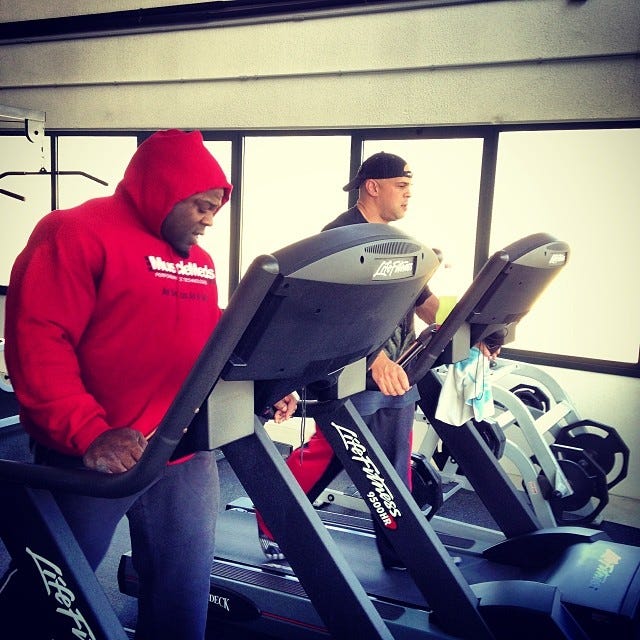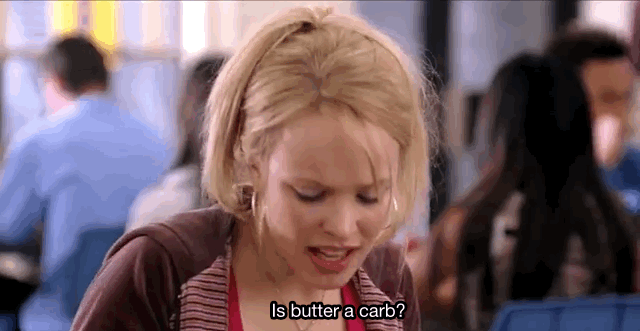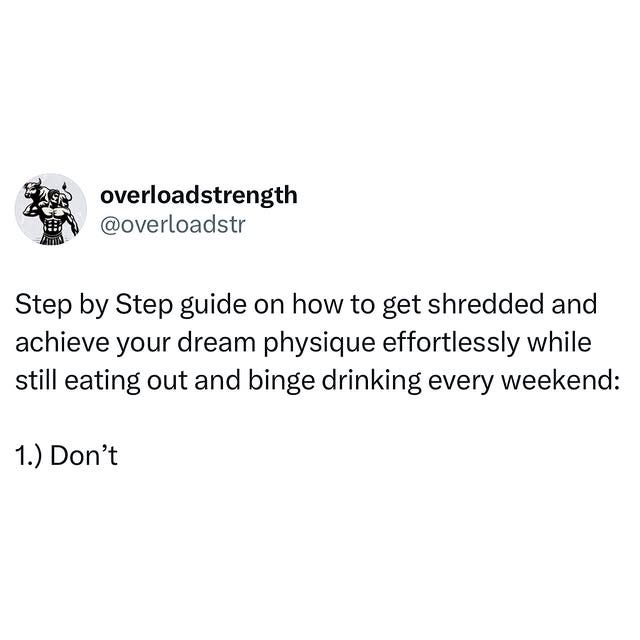Despite what social media gurus tell you, fat loss really isn’t that complicated. There is however a ton of misinformation on the internet that oftens leads to paralysis by analysis. One often debated take on fat loss is whether you should do high reps or low reps for fat loss.
The answer is simple, because it’s the same as for anything else.
“It Depends.”
Let’s tackle some myths first before we dive into my recommendation.
The Myths
#1 “You can’t gain strength or muscle in a caloric deficit”
This is actually something I believed in to a large extent for a while. Not necessary that it was impossible, but that it was less probable to gain much strength & muscle during a caloric deficit. The theory was that if you had less energy availability it would effect recovery between sessions, meaning fatigue would accumulate and consequently cause a drop in performance.
A similar argument can be made for muscle gain. Since you have less energy available, your body has less resources to put on size.
On the surface it sounds like being in a caloric deficit would cause a decrease in performance and inferior gains. However, the question rally should be whether or not that’s a substantial decline.
If we’re comparing two “equal” diets but one offers a slight caloric deficit and the other a calortic surplus, strength and muscle gain should improve in the surplus diet. This doesn’t however mean that the diet with the SLIGHT caloric deficit would cause massively inferior gains though.
Here’s the deal though, if you want to still get good results in a deficit there’s a few things you need to do. You need to be on top of your recovery.
Hit your protein targets, minimize stress
Eat decently high quality diet
Maintain only a slight (100-200 clorie) deificit
Aim to lose weight gradually (0.5-1.0% of total bodyweight per week)
If you’re doing the bullets above, you can reasonably expect to gain muscle and strength with your program even while in a deficit.
Too many words just sum it up for me nerd: Yes you can gain strength and muscle during a small caloric deficit. It likely won’t be as great as being in a surplus but if you manage your recovery well you can still expect to make pretty some gains.
#2 “Higher reps are better for fat loss since you burn more calories”
This ones tricky. In theory, performing 15 reps is 3 times more work than performing 5 reps (basic math). However, you need to take in the account that a 15 rep max (RM) is going to require much less weight and neurological demand than a 5 rep max. There will also be a different endocrine response to a 5 rep max than a 15 rep max.
Typically, heavier weights will trigger a greater acute hormonal response. For instance, a 5RM will initiate a stronger testosterone response then a 15RM.
It ain’t just about tanking your calories super low and ‘just lifting’. How you train and eat absolutely matters (it’s insane that I need to bring this up).
Most people aren’t just looking for fat loss, they want to tighten, “tone”, and improve their physique. Nobody wants to look skinny fat. If looking “toned” was all about calorie burn then the best program would just be something like an hour of stairmaster 3 times per week.
But it isn’t, you need to lift weights if you don’t want to look like a deflated balloon.
‘Everybody wanna be a bodybuilder, but don’t nobody want to lift no heavy ass weights’
Ronnie Coleman
The point of lifting weights isn’t to burn calories but to cause hormonal changes. If I pumped you full of testosterone, had you sit on the couch and not lift for 4 weeks, you’d gain muscle. Simply because you’re in a more anabolic state. We want to do the same thing with training. Zumba classes probably won’t boost your testosterone, slinging some heavy iron will do a better job.
We don’t want to burn calories, we want to create an anabolic state.
That same anabolic state will help to shed fat AND put on muscle. This is often why people that go on TRT will lose fat even without changing their diet. I would therefore recommend still lifting to failure and not shying away from heavy weights.
It sounds counterintuitive to recommend anabolism if the goal is fat loss (catabolism). I’m simply talking about it from a hormonal standpoint. Again, if the goal was a total catabolic state I’d just have you hit hours of stairmaster and starve yourself. Not ideal unless you want to look like a wet bag of spaghetti.
Too many words just sum it up for me nerd: Don’t chase calorie burn, chase a hormonal response. Lift heavy still and push yourself regardless if it’s for high reps or low reps. Lifting heavy while cutting can still be beneficial.
Fat Loss Rx
Be in a caloric deficit
Aim for 0.5% - 1.0% of total bodyweight loss per week.
Intake 0.8 - 1.0 g / lb of bodyweight in protein
Walk 10,000 steps a day
Increase the metabolic demand of your training
Train Hard
I need to include this because people forget about this part
To determine your caloric deficit I highly recommend finding your maintenance calories first. There are a million calculators you can find online for this or you can do it the quick and dirty way.
Quick and Dirty Calorie Calculation
Low Activity
Bodyweight (lbs) x 14 = Calories Per Day For Maintenance
Example: 165 lbs x 14 = 2310 calories per day
Moderate Activity
Bodyweight (lbs) x 15 = Calories Per Day For Maintenance
High Activity
Bodyweight (lbs) x 16 = Calories Per Day For Maintenance
Once you have your estimated number, track your intake for a week to determine if it’s accurate. I have a more detailed description of this process in my nutrition manual.
Alternatively, you could use a calculator like this one: Mifflin St Jeor Calculator
Simply adjust your calories after that week to estimate maintenance, and test for another week. This step is super important, you want to minimize guess work. Calculate your protein and fill in the blanks with carbs and fat, don’t overthink it.
There’s nothing magical about 10,000 steps a day, it just tends to be the threshold for most people where they’re forced to be active througout the day. You’re able to keep your non-exercise activity (NEAT) elevated so you won’t need to take calories super low.
Fat Loss Training
I strongly believe that you should focus on one primary goal at a time. This doesn’t mean you 100% ignore doing cardio if your goal is getting a big squat. It just means the training is heavily biased toward developing one quality. If your goal is fat loss, you could still lift heavy (1 to 5 reps) but if it’s truly the number one goal then i’d recommend more metabolically demanding training for a period of 8 to 12 weeks.
The most effective fat loss training program i’ve ran with clients was something I learned from Kilo Strength Society and Charles Poliquin: German Body Comp (GBC) Training.
GBC won’t make you freakishly strong, but damn does it make you work. You’ll also preserve lean tissue and won’t need to spend hours on the stairmaster each week, win win.
Note: This isn’t a program for beginners. You likely won’t be able to go heavy enough to get the benefit. If you’re a beginner I recommend training Full Body 3x/week and adding in either modified strongman circuits, sled or assault bike sprints, or just traditional steady state cardio.
I only recommend GBC for about 3 weeks before shifting into another phase. I like the structure below that I picked up from a fat loss course I took a couple years ago.
GBC 1 (3 Weeks)
Agonist Superset (3 Weeks)
GBC 2 (3 Weeks)
Post Exhaustion (3 Weeks)
If you want the full program I have a discounted version of it through the Everfit App here. It’s a 12 week program and I wouldn’t recommend it for beginners. It’s tough and requires proficiency in major compound lifts.
Fat Loss For Strength Athletes
GBC or the 12 week program above is still a good option if you got a couple of months to dedicate to fat loss. Otherwise I’d recommend something like an upper lower split 4x /week and keep your programming similar as usual but add in metabolically demanding accessories or circuits to your training.
Examples:
Lower Body
A1 Squat 5 x 5
B1 Leg Press 4 x 20
B2 Dumbbell Lunge 4 x 10 each side
C1 Sled Push 4 x 30 sec , 30 sec rest
In the B series performing high rep leg press with dumbbell lunges and then finishing with the sled is metabolically demanding compared to a more typical accessory structure for strength training. However, you still hit some heavy weight (5x5 squats).
Upper Body
A1 Bench Press 5 x 5
B1 Pushup 4 x 20
B2 Incline Dumbbell Bench Press 4 x 10-12
C1 Giant Set Circuit (3-5 movements done with no rest)
The giant set circuit should include 2-3 strength movements, a “burner” (any movement that makes you sweat: sled, heavy carries for 40-80 yards, ski, bike, row, med ball slams, kettlebell swings, mbear crawls, etc), and maybe a core exercise. Rest either 1-2 min after each giant set or not at all. Altenate between pressing and pulling motions in the giant set!
Another Great option would be something like Ascending Velocity training (AVT) or giant sets. This article will be textbook length if I list every single fat loss method so let me get into these two briefly and then send you on your way.
Ascending Velocity
A1 Back Squat 6 x 6 4010
A2 Double Kettlebell Front Rack Squat 6 x 12 3010
A3 Reactive Bodyweight Jump Squat 6 x 15 10X0
You would ideally do this and then 6 sets of a pulling or pressing tri set with a similar structure. You can see the tempo starts slow (4010) and gets faster each exercise, hence, Ascending Velocity. This sucks.
Giant Sets Option A Agonist Muscle Groups
A1 Bench Press 4 x 8
A2 Incline Dumbell Bench Press 4 x 10
A3 Dumbbell Fly 4 x 12
A4 Pushup 4 x 15
Rest 2-3 min
B1 Barbell Rows 4 x 8
B2 Chest Supported Dumbbell Row 4 x 10
B3 Band Straight Arm Pulldowb 4 x 20
B4 Band Facepull 4 x 20
Rest 2-3 min
Giant Sets Full Body
A1 Back Squat 5 x 10
A2 Incline Dumbbell Bench Press 5 x 10
A3 Hamstring Curl 5 x 10
A4 Single Arm Dumbbell Row 5 x 10
Rest 1-2 min and then perform another series with different movements, hit a giant set accessory circuit, or hit some metabolic conditioning.
Stay Strong.












I prefer your meathead calling someone a nerd summary prompt to the TL/DR acronym. Great stuff brother. Diving into the why and nuance behind common myths.